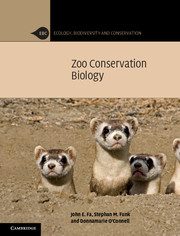Book contents
- Frontmatter
- Contents
- Foreword
- Preface
- Acknowledgements
- 1 Biodiversity and zoo conservation biology
- 2 Protecting species and habitats
- 3 Zoos in focus – public exhibition or conservation
- 4 Keeping animals in captivity
- 5 Viable captive populations – the numbers game
- 6 Captive breeding and zoos
- 7 Returning animals to the wild
- 8 Educating the public
- 9 Turning zoos into conservation centres
- Appendix 1 Commonly used abbreviations
- Appendix 2 Scientific names of species mentioned in the text
- Appendix 3 Inbreeding
- Appendix 4 Population sizes – definitions and implications
- Appendix 5 Captive breeding and genetics – definitions
- References
- Index
- Plate section
3 - Zoos in focus – public exhibition or conservation
Published online by Cambridge University Press: 05 August 2012
- Frontmatter
- Contents
- Foreword
- Preface
- Acknowledgements
- 1 Biodiversity and zoo conservation biology
- 2 Protecting species and habitats
- 3 Zoos in focus – public exhibition or conservation
- 4 Keeping animals in captivity
- 5 Viable captive populations – the numbers game
- 6 Captive breeding and zoos
- 7 Returning animals to the wild
- 8 Educating the public
- 9 Turning zoos into conservation centres
- Appendix 1 Commonly used abbreviations
- Appendix 2 Scientific names of species mentioned in the text
- Appendix 3 Inbreeding
- Appendix 4 Population sizes – definitions and implications
- Appendix 5 Captive breeding and genetics – definitions
- References
- Index
- Plate section
Summary
‘Times are hard for zoos. If they would dedicate themselves wholeheartedly to entertaining the public, life might be easier at least financially, but almost all say they exist for the purpose of conservation’
(Jeremy Cherfas)Introduction
Contact or involvement with animals has been a dominant feature of many civilisations for centuries (Bostock, 1993; Cherfas, 1984). Collections of wild animals in private and public institutions, zoos, have been in existence since antiquity. However, zoos have long been a source of controversy. Many people feel that the keeping of animals for public display is inhumane and unethical, while others argue that zoos serve as wildlife education, by providing the opportunity for individuals to view and learn about animals they would not otherwise have the chance to see (Mazur, 2001).
- Type
- Chapter
- Information
- Zoo Conservation Biology , pp. 53 - 83Publisher: Cambridge University PressPrint publication year: 2011

